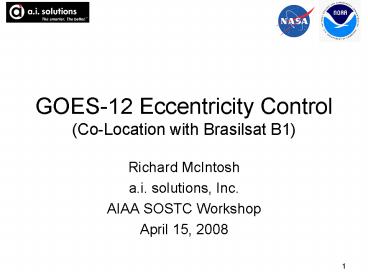GOES12 Eccentricity Control CoLocation with Brasilsat B1 - PowerPoint PPT Presentation
1 / 24
Title:
GOES12 Eccentricity Control CoLocation with Brasilsat B1
Description:
?V from SRP. Raises Apogee. ?V from SRP. Lowers Perigee. SRP. Effect of Solar Radiation Pressure on Eccentricity. 6. EX = e cos(O ?) EY = e sin(O ?) ... – PowerPoint PPT presentation
Number of Views:85
Avg rating:3.0/5.0
Title: GOES12 Eccentricity Control CoLocation with Brasilsat B1
1
GOES-12 Eccentricity Control(Co-Location with
Brasilsat B1)
- Richard McIntosh
- a.i. solutions, Inc.
- AIAA SOSTC Workshop
- April 15, 2008
2
Co-Location Requirements
- GOES-12 located at 75 deg W /- 0.5 deg
longitude. - Brasilsat B1 given OK to move from 70 deg W to 75
deg W and maintain /- 0.1 deg longitude. - B1 now occupies the middle 0.2 deg of GOES-12
box. - StarOne (B1 owners) suggested eccentricity vector
control to avoid close approaches. - GOES maneuver control software not capable of
planning East-West stationkeeping (EWSK)
maneuvers that include eccentricity vector
control. - NOAA desires to not perform any extra maneuvers
for eccentricity control. - Analysis performed to determine how eccentricity
control could be incorporated into the normal
1-burn EWSK operations.
3
(No Transcript)
4
Eccentricity Control Strategy Recommended By
StarOne
Eccentricity Vector ex e cos(O?) ey e
sin(O?)
5
Effect of Solar Radiation Pressure on
Eccentricity
6
Natural Eccentricity Circle (size depends on
Area/Mass)
EX e cos(O?)
EY e sin(O?)
7
(No Transcript)
8
Eccentricity Control
- Eccentricity vector will tend to follow the
natural circle throughout the year. - Desired control circle size is usually smaller.
- Objective is to try to make a short arc of the
natural circle closely follow the control circle
over the next EWSK cycle. - EWSK frequency
- GOES-12 every 11 or 12 weeks
- B1 every 3 weeks
9
Sun at End
ß
?a Change in Sun RA over 1 East-West
Maneuver Cycle
EY
Sun at Start
ß
EX
?a
Control Circle
Natural Circle
10
EY
Next E-W Cycle
ß
?e
ß
EX
?a
Control Circle
Natural Circle
11
Equations (1 of 3)
12
Equations (2 of 3)
?e
RA1
13
Equations (3 of 3)
Note Delta-Vs are normally in negative velocity
direction for 75 West
14
1-Burn vs 2-Burn Control
1-Burn -0.268 m/s
2-Burns -0.478 and 0.211 m/s
15
Single Burn at Perigee
16
2-Burn Control 0.0003 Circle
17
2-Burn Control 0.0002 Circle
18
GOES-12 4-Year Simulation1-Burn East-West
Maneuvers
19
(No Transcript)
20
(No Transcript)
21
(No Transcript)
22
(No Transcript)
23
(No Transcript)
24
Conclusions
- Analysis has shown that sufficient eccentricity
control can be accomplished by GOES-12 with
little or no impact to the normal EWSK operations
(single-burn). - Only requirement is a change in the time of the
burn (move from the normal perigee burn
location). - NOAA has incorporated the equations presented
here into a spreadsheet that computes the nominal
time of the burn. - GOES-12 successfully performed the first EWSK
maneuver with eccentricity control on July 24,
2007. - Subsequent EWSK maneuvers have shown that the
single-burn strategy provides adequate
eccentricity control. - Further analysis needs to be done to verify that
the desired spacecraft separation can be
maintained in the long term.































